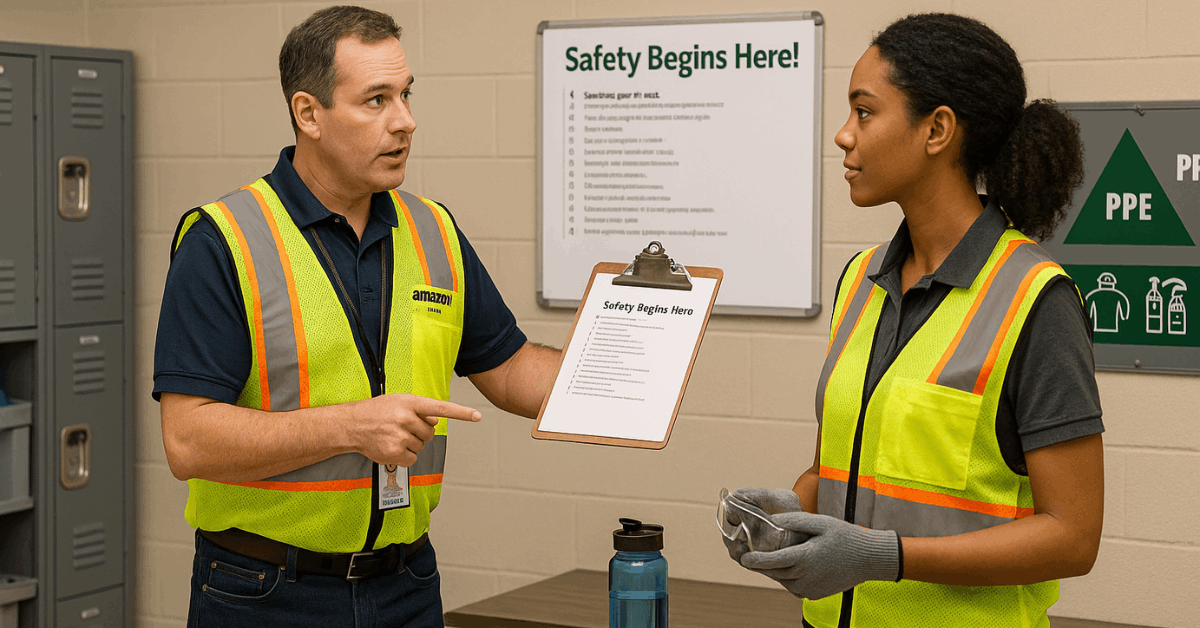In fast-moving logistics, Amazon Warehouse Jobs 2025 offer steady demand, predictable shift options, and clear paths into higher-paid technical roles.
Amazon’s global workforce sits around 1.56 million employees, and fulfillment operations continue hiring even as corporate restructuring reshapes office teams.
Seasonal surges and site expansions keep entry routes open for reliable candidates who pass basic screens and align with leadership expectations. Headcount and hiring cadence vary by country, so confirm local steps on the official portals before applying.

What Hiring Looks Like Now
Across fulfillment, sortation, and delivery stations, hourly openings typically appear year-round, with extra demand before peak seasons.
Posting language consistently highlights fixed shifts, weekend coverage, and physical requirements such as standing for long periods and lifting up to 49 pounds, which sets clear expectations before any appointment.
Availability alignment and clean background results usually determine start speed more than prior industry experience. Most sites publish the same core physical standards and emphasize adherence to safety protocols and site rules.
How the Amazon Warehouse Hiring Process Works
Expect a streamlined flow focused on eligibility and readiness rather than multiple interviews. Timelines differ by location, but the steps below describe the common path for fulfillment and delivery stations.
Processing moves faster when shift selection, documents, and screening windows are handled promptly. Local regulations and third-party providers can slightly extend background or drug-testing turnaround times.
1. Online Application and Shift Selection
Applications begin on Amazon’s hiring portal, where candidates enter basic details and select preferred shifts; this step generally takes minutes, not hours.
Many hourly warehouse roles don’t require a resume, and several country sites note that most hourly jobs, including warehouse, accept applications without one.
2. Conditional Offer and Pre-Hire Appointment
Qualified applicants frequently receive a conditional offer pending screens, then book a pre-hire appointment to complete identity verification and onboarding steps.
The appointment typically includes Form I-9 in the U.S. and any region-specific right-to-work checks.
3. Background Check and Drug Test
Facilities commonly require a background screen and, for many roles, a drug test; postings explicitly state these pre-employment conditions. Safety-sensitive positions and pharmacy-adjacent roles also note drug testing requirements in job descriptions.
4. Start Date and Ramp-Up
After clearance, candidates receive a start date, sometimes within one to two weeks depending on site demand and screening completion. New hires get site safety briefings and role-specific training tied to standard work and productivity goals.
When Interviews Happen and How to Prepare
Most entry-level roles proceed without a traditional interview; readiness proofs come through forms, screens, and appointment attendance.
Brief interviews appear more often for Process Assistant, Area Manager pipelines, or during special hiring events. Preparation still matters because short conversations often probe safety awareness, stamina for repetitive tasks, and fit with leadership principles.
Structuring answers with the SOAR interview method or STAR keeps stories concise and evidence-based. Common prompts to practice include:
- Describe experience in fast-paced, repetitive work while maintaining quality.
- Explain how safety was upheld during a heavy shift or tight deadline.
- Share a time ownership was taken to fix a workflow problem.
- Outline steps to stay accurate when scanning, picking, or staging items.
- Give an example of using data to improve personal or team performance.
Interviewers benchmark replies against Amazon’s Leadership Principles, sixteen behaviors used across teams and levels, so mapping stories to principles like Customer Obsession, Ownership, and Deliver Results shows alignment quickly.
Safety, Physical Demands, and Readiness
Warehousing brings predictable risks: moving equipment, pinch points, variable temperatures, and repetitive lifts. OSHA’s warehousing guidance emphasizes clear aisles, powered-equipment maintenance, signage, and training for manual handling, habits mirrored in site rules and daily huddles.
Wearing required PPE, using proper lifting mechanics, rotating tasks where possible, and flagging hazards immediately reduce injuries and downtime for the whole shift.
Facilities also publish job pages stating the frequent need to stand, walk, push, pull, squat, bend, and reach for extended periods, which makes pre-shift stretching and hydration practical, not optional.
Why Applications Stall or Get Rejected
Clear expectations help avoid preventable setbacks. Screens automatically move candidates out of the pipeline when required items aren’t completed on time, so monitor the portal closely and keep documents ready.
Accuracy and completeness beat speed when uploading IDs and forms.
- Incomplete or inconsistent information on the application or I-9 paperwork triggers delays or removals.
- Mismatch on job requirements, such as shift availability or the ability to meet stated physical standards, blocks offers.
- Unsuccessful background or drug screens end consideration for most roles, especially safety-sensitive positions.
- Missed appointments or deadlines inside the candidate account cause rescinded or expired conditional offers.
Standout Tactics for Fast Offers
Resume tailoring still helps, even where a resume isn’t mandatory, because a concise skills summary improves quick manager reviews. Quantify throughput, accuracy, or attendance to mirror metrics on the floor, then cap bullets to essentials.
For brief interviews, anchor answers to Amazon leadership principles examples using SOAR: define the Situation, name the Obstacle, list your Actions, and quantify the Result.
Being specific about safety adds credibility, for example noting prior PPE use, lockout/tagout awareness in previous environments, or learning to spot blocked egress and unstable stacking.

Roles, Shifts, and What to Expect on Day One
Fulfillment Center Associate, Sortation Associate, and Delivery Station roles share core motions: scanning, picking, staging, and loading.
Posts routinely advertise Amazon shift schedules covering days, nights, and weekends, with overtime possible during peak.
New hires can expect structured training, a badge checklist, and exposure to productivity dashboards that track rate and quality. Consistency across early weeks matters more than single high-output days; steady, safe performance satisfies both leadership expectations and metric targets.
2025 Context: Hiring Stays Active Where Operations Grow
Corporate job cuts tied to AI reorganization have dominated headlines; fulfillment hiring, however, aligns primarily with local volume and facility openings.
News reports estimate about 14,000 corporate roles impacted in late October 2025 while Amazon continued expanding logistics investments and seasonal hiring.
Candidates targeting warehouse roles should track local postings and appointment calendars rather than reading corporate news as a proxy for site-level staffing plans.
Practical Prep Checklist
Align shift availability to the posted need, then finish every portal step immediately after receiving a conditional offer.
Bring required IDs to the appointment, wear closed-toe shoes, and budget time for drug testing if applicable.
Prepare two SOAR stories focused on safety and one on throughput accuracy, and map each to a leadership principle like Ownership or Deliver Results. Warm up pre-shift, learn power-zone lifting, and report hazards without delay; that mindset gets noticed quickly by Process Assistants and Area Managers.
Conclusion
In 2025, steady warehouse demand favors you when availability aligns, screens finish promptly, and safety discipline stays obvious.
Across fulfillment, fixed shifts and physical standards are non-negotiable, so set realistic preferences and bring your required documents. When interviews appear, map concise SOAR examples to Leadership Principles, highlighting your ownership, safe throughput, and dependable attendance.
After onboarding, consistent performance and curiosity unlock Career Choice education, RME pathways, and faster moves into higher-paid roles for you.












